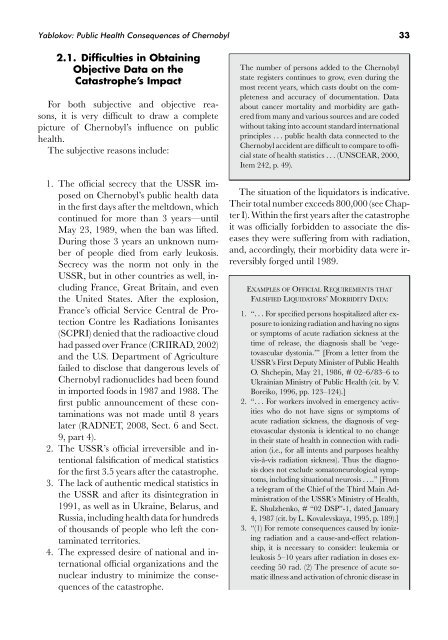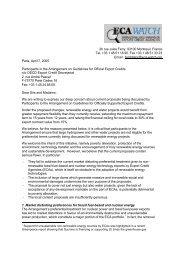PDF copy of 2009 book
PDF copy of 2009 book
PDF copy of 2009 book
You also want an ePaper? Increase the reach of your titles
YUMPU automatically turns print PDFs into web optimized ePapers that Google loves.
Yablokov: Public Health Consequences <strong>of</strong> Chernobyl 332.1. Difficulties in ObtainingObjective Data on theCatastrophe’s ImpactFor both subjective and objective reasons,it is very difficult to draw a completepicture <strong>of</strong> Chernobyl’s influence on publichealth.The subjective reasons include:1. The <strong>of</strong>ficial secrecy that the USSR imposedon Chernobyl’s public health datain the first days after the meltdown, whichcontinued for more than 3 years—untilMay 23, 1989, when the ban was lifted.During those 3 years an unknown number<strong>of</strong> people died from early leukosis.Secrecy was the norm not only in theUSSR, but in other countries as well, includingFrance, Great Britain, and eventhe United States. After the explosion,France’s <strong>of</strong>ficial Service Central de ProtectionContre les Radiations Ionisantes(SCPRI) denied that the radioactive cloudhad passed over France (CRIIRAD, 2002)and the U.S. Department <strong>of</strong> Agriculturefailed to disclose that dangerous levels <strong>of</strong>Chernobyl radionuclides had been foundin imported foods in 1987 and 1988. Thefirst public announcement <strong>of</strong> these contaminationswas not made until 8 yearslater (RADNET, 2008, Sect. 6 and Sect.9, part 4).2. The USSR’s <strong>of</strong>ficial irreversible and intentionalfalsification <strong>of</strong> medical statisticsfor the first 3.5 years after the catastrophe.3. The lack <strong>of</strong> authentic medical statistics inthe USSR and after its disintegration in1991, as well as in Ukraine, Belarus, andRussia, including health data for hundreds<strong>of</strong> thousands <strong>of</strong> people who left the contaminatedterritories.4. The expressed desire <strong>of</strong> national and international<strong>of</strong>ficial organizations and thenuclear industry to minimize the consequences<strong>of</strong> the catastrophe.The number <strong>of</strong> persons added to the Chernobylstate registers continues to grow, even during themost recent years, which casts doubt on the completenessand accuracy <strong>of</strong> documentation. Dataabout cancer mortality and morbidity are gatheredfrom many and various sources and are codedwithout taking into account standard internationalprinciples ...public health data connected to theChernobyl accident are difficult to compare to <strong>of</strong>ficialstate <strong>of</strong> health statistics ...(UNSCEAR, 2000,Item 242, p. 49).The situation <strong>of</strong> the liquidators is indicative.Their total number exceeds 800,000 (see ChapterI). Within the first years after the catastropheit was <strong>of</strong>ficially forbidden to associate the diseasesthey were suffering from with radiation,and, accordingly, their morbidity data were irreversiblyforged until 1989.EXAMPLES OF OFFICIAL REQUIREMENTS THATFALSIFIED LIQUIDATORS’MORBIDITY DATA:1. “...For specified persons hospitalized after exposureto ionizing radiation and having no signsor symptoms <strong>of</strong> acute radiation sickness at thetime <strong>of</strong> release, the diagnosis shall be ‘vegetovasculardystonia.’” [From a letter from theUSSR’s First Deputy Minister <strong>of</strong> Public HealthO. Shchepin, May 21, 1986, # 02–6/83–6 toUkrainian Ministry <strong>of</strong> Public Health (cit. by V.Boreiko, 1996, pp. 123–124).]2. “... For workers involved in emergency activitieswho do not have signs or symptoms <strong>of</strong>acute radiation sickness, the diagnosis <strong>of</strong> vegetovasculardystonia is identical to no changein their state <strong>of</strong> health in connection with radiation(i.e., for all intents and purposes healthyvis-à-vis radiation sickness). Thus the diagnosisdoes not exclude somatoneurological symptoms,including situational neurosis ....” [Fromatelegram<strong>of</strong>theChief<strong>of</strong>theThirdMainAdministration<strong>of</strong> the USSR’s Ministry <strong>of</strong> Health,E. Shulzhenko, # “02 DSP”-1, dated January4, 1987 (cit. by L. Kovalevskaya, 1995, p. 189).]3. “(1) For remote consequences caused by ionizingradiation and a cause-and-effect relationship,it is necessary to consider: leukemia orleukosis 5–10 years after radiation in doses exceeding50 rad. (2) The presence <strong>of</strong> acute somaticillness and activation <strong>of</strong> chronic disease in




